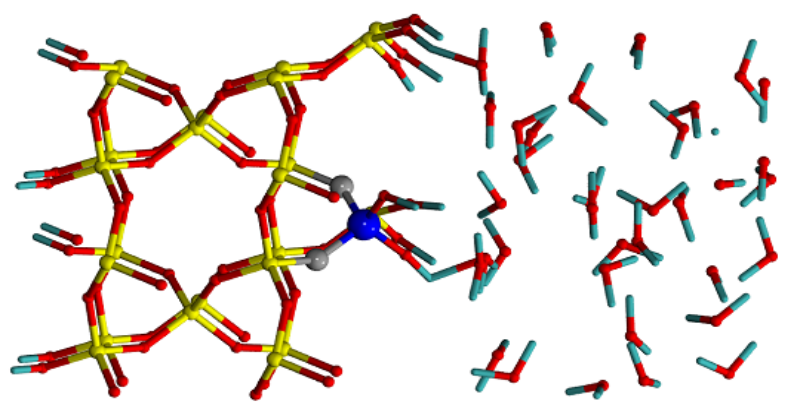Research / Annual reports / Main research results of the Institute for Condensed Matter Physics of NAS of Ukraine in 2013
Main research results of the Institute for Condensed Matter Physics of NAS of Ukraine in 2013
a) Main fundamental results
 Structural, electronic and dynamic properties of liquid Rb at T=573K and a pressure range up to 27.4 Gpa were studied be means of ab initio molecular dynamics simulations. The temperature corresponded to the one in inelastic X-ray scattering experiments performed for liquid Rb for pressures up to 6.6 GPa, and the aim was in ab initio calculations of dynamic structure factors and features of sound propagation at high pressures. The simulations were performed on a system of 300 particles with PAW electron-ion interactions for seven pressures. At high pressures the electron subsystem is under geometrical restrictions imposed by atomic cores, that leads to a partial localization of electrons in interatomic space. In figure the isosurfaces of electron localization functions are shown for the smallest and highest pressures in the simulations. The existence of the partially localized electrons affects essentially the dynamic properties of the metallic melt. An important result was obtained for diffusion coefficients D: in the pressure range 10-17 GPa a slowing down of the reduction of D vs pressure, that is a consequence of core softening of Rb particles. This finding is in agreement with the results for electronic system, because at high pressures the electrons are being squeezed out to the intercore space. Namely in the same pressure range there was observed a slowing down of the increase of the speed of sound vs pressure, that can be an evidence of a pressure-induced structural liquid-liquid transformation due to changes in the electronic structure and reduction of cores of Rb particles. (T. Bryk).
Structural, electronic and dynamic properties of liquid Rb at T=573K and a pressure range up to 27.4 Gpa were studied be means of ab initio molecular dynamics simulations. The temperature corresponded to the one in inelastic X-ray scattering experiments performed for liquid Rb for pressures up to 6.6 GPa, and the aim was in ab initio calculations of dynamic structure factors and features of sound propagation at high pressures. The simulations were performed on a system of 300 particles with PAW electron-ion interactions for seven pressures. At high pressures the electron subsystem is under geometrical restrictions imposed by atomic cores, that leads to a partial localization of electrons in interatomic space. In figure the isosurfaces of electron localization functions are shown for the smallest and highest pressures in the simulations. The existence of the partially localized electrons affects essentially the dynamic properties of the metallic melt. An important result was obtained for diffusion coefficients D: in the pressure range 10-17 GPa a slowing down of the reduction of D vs pressure, that is a consequence of core softening of Rb particles. This finding is in agreement with the results for electronic system, because at high pressures the electrons are being squeezed out to the intercore space. Namely in the same pressure range there was observed a slowing down of the increase of the speed of sound vs pressure, that can be an evidence of a pressure-induced structural liquid-liquid transformation due to changes in the electronic structure and reduction of cores of Rb particles. (T. Bryk).
Досліджено конформаційні властивості заряджених полімерів (поліамфолітів) у розчинах із домішками, що скорельовані на мезоскопічному масштабі за степеневим законом із показником a. Застосовуючи підхід прямого полімерного перенормування, для моделі неперервного ланцюжка проаналізовано можливі сценарії скейлінгової поведінки поліамфолітів при різних значеннях параметра a. Чисельні дослідження проведено в рамках граткової двокомпонентної моделі поліамфоліта з сильно екранованою електростатичною взаємодією. У теоретико-польовому ренорм-груповому підході доведено еквівалентність впливу замороженого та відпаленого типів безладу на універсальні скейлінгові властивості гнучких полімерних макромолекул (Блавацька В.Б.).
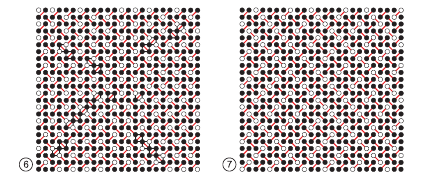 Досліджено механізм появи дробових плато (зокрема плато 1/2) на залежностях намагніченості від магнітного поля у деяких тетраборатах рідкісноземельних металів, які мають квазідвовимірну структуру з ґраткою Шастри-Сазерленда і можуть вважатися магнетиками ізингового типу. Методом основних векторів і основних множин конфігурацій кластера знайдено розв’язок задачі про основні стани моделі Ізинга на такій ґратці зі взаємодією перших, других і третіх сусідів у зовнішньому полі. Показано, що модель має дев’ять повновимірних структур основного стану з невід’ємною намагніченістю, три з яких породжують плато 1/2 і дві з них є частково хаотизованими. Зроблено висновок, що плато 1/2 у таких системах породжує взаємодія третіх сусідів, тобто взаємодія вздовж діагоналей «порожніх» квадратів на ґратці Шастри-Сазерленда (Дубленич Ю.І.).
Досліджено механізм появи дробових плато (зокрема плато 1/2) на залежностях намагніченості від магнітного поля у деяких тетраборатах рідкісноземельних металів, які мають квазідвовимірну структуру з ґраткою Шастри-Сазерленда і можуть вважатися магнетиками ізингового типу. Методом основних векторів і основних множин конфігурацій кластера знайдено розв’язок задачі про основні стани моделі Ізинга на такій ґратці зі взаємодією перших, других і третіх сусідів у зовнішньому полі. Показано, що модель має дев’ять повновимірних структур основного стану з невід’ємною намагніченістю, три з яких породжують плато 1/2 і дві з них є частково хаотизованими. Зроблено висновок, що плато 1/2 у таких системах породжує взаємодія третіх сусідів, тобто взаємодія вздовж діагоналей «порожніх» квадратів на ґратці Шастри-Сазерленда (Дубленич Ю.І.).
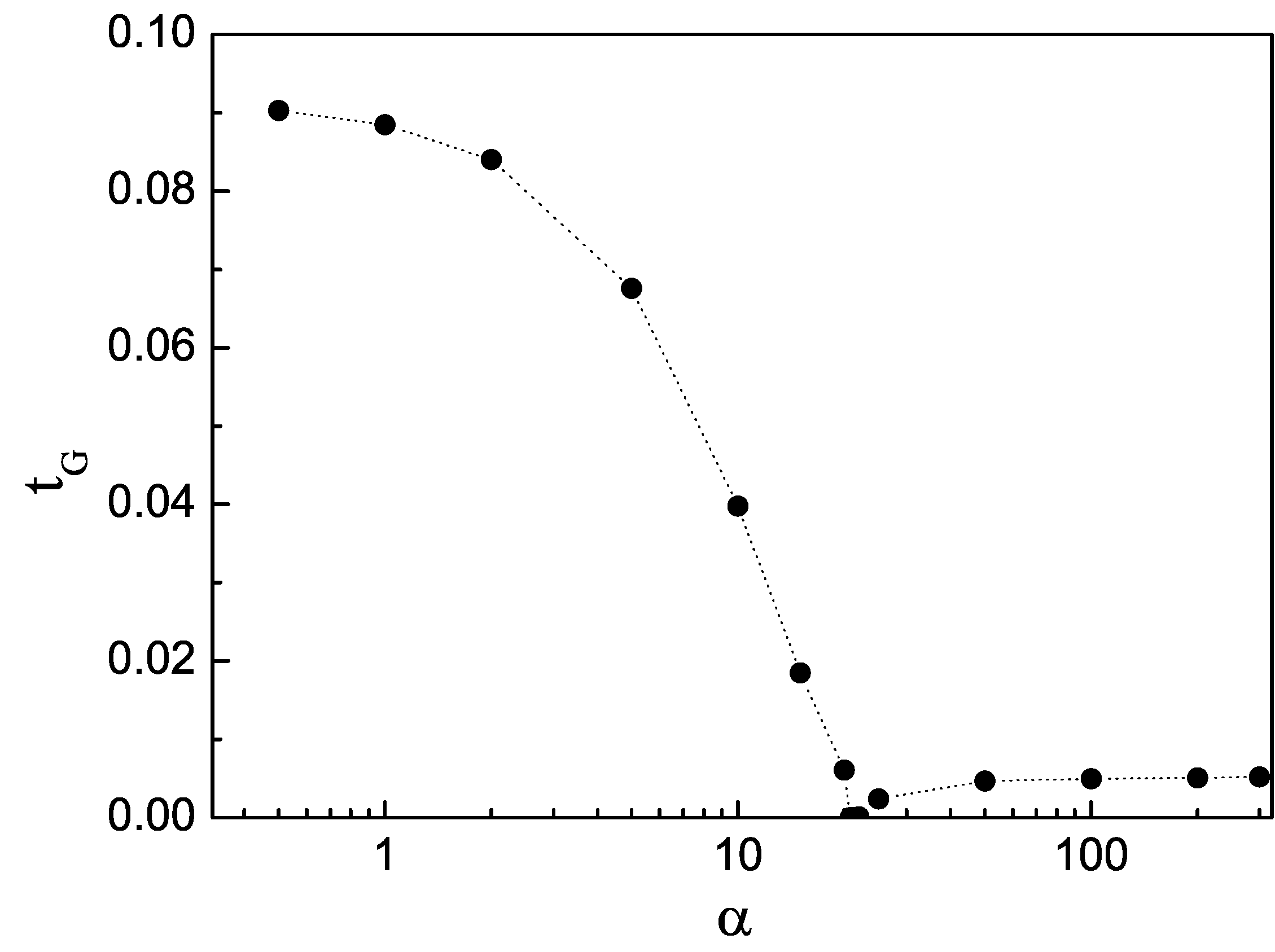 For the first time, it is strictly shown within the framework of the self-consistent approach that the reduced Ginzburg temperature for the gas-liquid critical point of the restricted primitive model is about 20 times smaller than for nonionic models. For the generalized model which, besides Coulomb interactions, includes short-range attraction we calculate the Ginzburg temperature for various values of the interaction strength. It is shown that the Ginzburg temperature approaches the value found for the primitive model when the strength of the Coulomb interactions become sufficiently large. This result explains the experimental data which indicate an increase of the non-classical region with an increase of the solvent dielectric constant (Patsahan O.V.).
For the first time, it is strictly shown within the framework of the self-consistent approach that the reduced Ginzburg temperature for the gas-liquid critical point of the restricted primitive model is about 20 times smaller than for nonionic models. For the generalized model which, besides Coulomb interactions, includes short-range attraction we calculate the Ginzburg temperature for various values of the interaction strength. It is shown that the Ginzburg temperature approaches the value found for the primitive model when the strength of the Coulomb interactions become sufficiently large. This result explains the experimental data which indicate an increase of the non-classical region with an increase of the solvent dielectric constant (Patsahan O.V.).
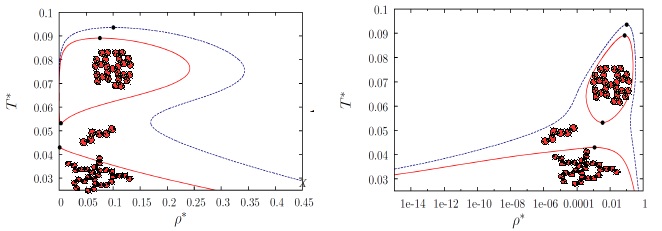 A second-order thermodynamic perturbation theory for a hard-sphere patchy colloidal model with two doubly bondable patches of type A and B is proposed. AB bonding results in the formation of a three-dimensionsl network of the particles and AA and BB bonding promotes chain formation. The theory is applied to study the phase behaviour of the model at different values of the potential model parameters. Competition between network and chain formation gives rise to a re-entrant phase behaviour with upper and lower critical points. The model with an additional van der Waals type of interaction may have a re-entrant phase diagram with three critical points and two separate regions of the liquid-gas phase coexistence. (Yu. Kalyuzhnyi).
A second-order thermodynamic perturbation theory for a hard-sphere patchy colloidal model with two doubly bondable patches of type A and B is proposed. AB bonding results in the formation of a three-dimensionsl network of the particles and AA and BB bonding promotes chain formation. The theory is applied to study the phase behaviour of the model at different values of the potential model parameters. Competition between network and chain formation gives rise to a re-entrant phase behaviour with upper and lower critical points. The model with an additional van der Waals type of interaction may have a re-entrant phase diagram with three critical points and two separate regions of the liquid-gas phase coexistence. (Yu. Kalyuzhnyi).
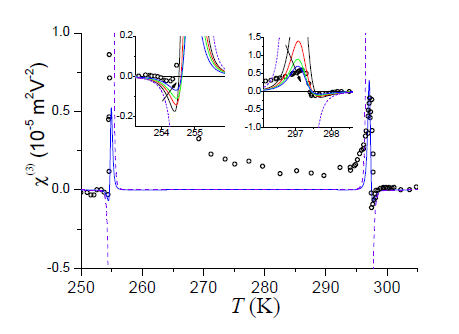 The deformable pseudospin Mitsui model is modified in order to take into account interactions of the ordering dipoles of Rochelle salt with dipoles, associated with switchable crystal defects. Using the Glauber-type kinetics of the ordering and defect pseudospins, we calculate the linear, second, and third order dynamic susceptibilities and piezoelectric coefficients of the system. The defect-assisted dispersion of the dynamic characteristics below 1 kHz is described. Behavior of the linear and non-linear susceptibilities close to the upper and lower Curie temperatures is also satisfactorily described by the presented model. (A. Moina).
The deformable pseudospin Mitsui model is modified in order to take into account interactions of the ordering dipoles of Rochelle salt with dipoles, associated with switchable crystal defects. Using the Glauber-type kinetics of the ordering and defect pseudospins, we calculate the linear, second, and third order dynamic susceptibilities and piezoelectric coefficients of the system. The defect-assisted dispersion of the dynamic characteristics below 1 kHz is described. Behavior of the linear and non-linear susceptibilities close to the upper and lower Curie temperatures is also satisfactorily described by the presented model. (A. Moina).
 The quantum spin-1/2 orthogonal-dimer chain with the Heisenberg intra-dimer and Ising inter-dimer interactions in a magnetic field is considered by a rigorous approach. The model exhibits two intermediate fractional plateaux at one-quarter and one-half of the saturation magnetization. We have examined the effect of the exchange anisotropy in the XXZ Heisenberg intra-dimer interaction on the ground state. It is shown that the one-quarter and one-half plateaux may disappear from the magnetization curve for the ferromagnetic Heisenberg intra-dimer interaction. We have also rigorously studied the effect of frustrated interactions on the thermodynamic and magnetic properties of the model and show how the macroscopic degeneracy of the ground state is reflected in the low-temperature behavior of the magnetization, entropy and specific heat. A possibility of observing enhanced magnetocaloric effect during the adiabatic demagnetization is discussed in detail.(T. Verkholyak)
The quantum spin-1/2 orthogonal-dimer chain with the Heisenberg intra-dimer and Ising inter-dimer interactions in a magnetic field is considered by a rigorous approach. The model exhibits two intermediate fractional plateaux at one-quarter and one-half of the saturation magnetization. We have examined the effect of the exchange anisotropy in the XXZ Heisenberg intra-dimer interaction on the ground state. It is shown that the one-quarter and one-half plateaux may disappear from the magnetization curve for the ferromagnetic Heisenberg intra-dimer interaction. We have also rigorously studied the effect of frustrated interactions on the thermodynamic and magnetic properties of the model and show how the macroscopic degeneracy of the ground state is reflected in the low-temperature behavior of the magnetization, entropy and specific heat. A possibility of observing enhanced magnetocaloric effect during the adiabatic demagnetization is discussed in detail.(T. Verkholyak)
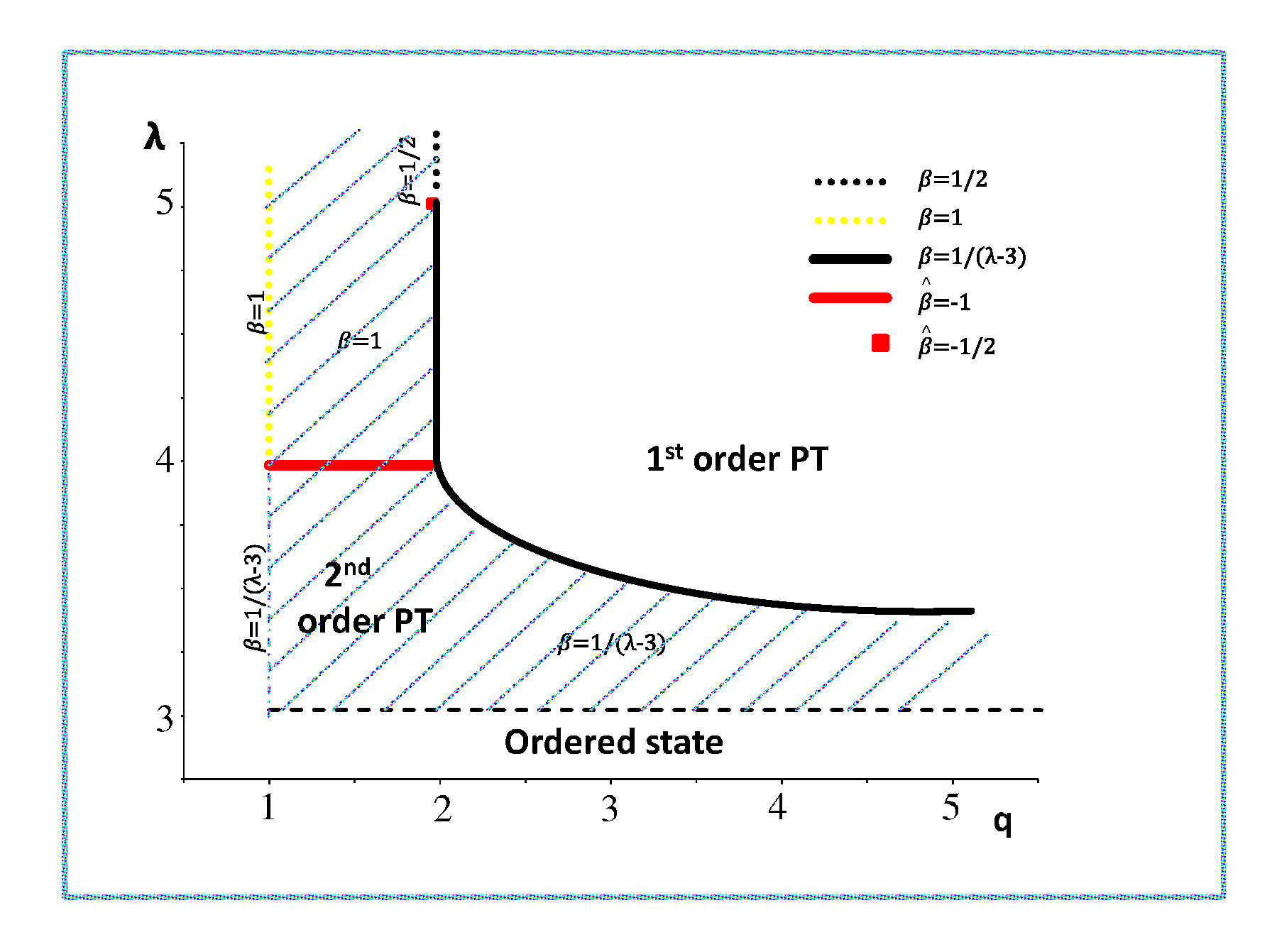 Critical behaviour of the q-state Potts model on an uncorrelated annealed network is analyzed. The case of a scale-free network is considered, when the decay of the node degree distribution function is governed by the power law with the exponent λ: P(k)~1/kλ. The phase diagram obtained (see figure) demonstrates, that depending of the values of q and λ the first or second order phase transitions are observed or the system is ordered at any finite temperature. It is shown that λ along with q defines the universality class in the second order phase transition region. Percolation on a scale-free network is considered as a limiting case q = 1, values of percolation critical exponentі are found. It is shown that logarithmic corrections to scaling appear in the marginal case λc=4. The comprehensive list of the logarithmic corrections to scaling exponents is obtained (M. Krasnytska, Yu. Holovatch).
Critical behaviour of the q-state Potts model on an uncorrelated annealed network is analyzed. The case of a scale-free network is considered, when the decay of the node degree distribution function is governed by the power law with the exponent λ: P(k)~1/kλ. The phase diagram obtained (see figure) demonstrates, that depending of the values of q and λ the first or second order phase transitions are observed or the system is ordered at any finite temperature. It is shown that λ along with q defines the universality class in the second order phase transition region. Percolation on a scale-free network is considered as a limiting case q = 1, values of percolation critical exponentі are found. It is shown that logarithmic corrections to scaling appear in the marginal case λc=4. The comprehensive list of the logarithmic corrections to scaling exponents is obtained (M. Krasnytska, Yu. Holovatch).
b) Main applied results
 Quantitative analysis of some features of the research efficiency evaluation is performed. In particular, two approaches for scientific groups’ evaluation are compared: the first one is based on the expert peer-review while the second one accounts citation-based measures. As a case study, we have analysed data about the research institutions in the UK. The expert evaluations were based on the data taken from the British system of evaluation of research and education (Research Assessment Exercise, RAE). The values of special normalized citation index calculated by Evidence (Thomson Reuters Research Analytics) were used as citation-based measure. It is shown that the intensive values (normalized on the number of group members) of citation-based indicators and peer-evaluated measures are weakly correlated (upper row in figure). On the other hand, the corresponding extensive values are strongly correlated (lower row in figure). Therefore, the rates based on the averaged values of citation-based indicators and the expert evaluations differ essentially. Our results may be useful during elaboration of strategies for scientific work efficiency evaluation. (O. Mryglod, Yu. Holovatch).
Quantitative analysis of some features of the research efficiency evaluation is performed. In particular, two approaches for scientific groups’ evaluation are compared: the first one is based on the expert peer-review while the second one accounts citation-based measures. As a case study, we have analysed data about the research institutions in the UK. The expert evaluations were based on the data taken from the British system of evaluation of research and education (Research Assessment Exercise, RAE). The values of special normalized citation index calculated by Evidence (Thomson Reuters Research Analytics) were used as citation-based measure. It is shown that the intensive values (normalized on the number of group members) of citation-based indicators and peer-evaluated measures are weakly correlated (upper row in figure). On the other hand, the corresponding extensive values are strongly correlated (lower row in figure). Therefore, the rates based on the averaged values of citation-based indicators and the expert evaluations differ essentially. Our results may be useful during elaboration of strategies for scientific work efficiency evaluation. (O. Mryglod, Yu. Holovatch).
Developed the first version of the computer program of synthesis of color image based on color separation of images obtained by the new information technology ICaS-ColorPrint®. Feature of the program is that it provides a direct output files color separation images on printing plate (CtP technology: Сomputer-to-Plate) and get an image file synthesized color image digital color print on paper (M. Shovgenyuk).
We propose a metadynamics-based scheme for the simulation of dissolution of quartz and other metal oxide minerals. The scheme reconstructs the free energy profile (FEP) in the multidimensional space of three collective variables, which are chosen to control all the elementary reactions taking place during the dissolution. The reactions include hydrolysis of the bridging oxygen (Si–O–Si) by protonating it and forming surface Si–O–H group and attaching hydroxyl group to the dissolved silica unit (H–O–Si). Using this approach, it is possible to achieve steady reoccurring dissolution and precipitation events during the simulation, which confirms that all the FEP basins are equally accessible, and, therefore, are properly filled during the reconstruction. We believe that the proposed here scheme should be extremely useful for the simulation of dissolution of minerals. And while it is more computationally expensive than the other conventional one-dimensional approaches, it, nevertheless, produces more accurate results. (S. Hlushak).
